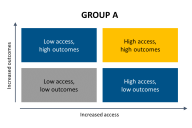You have /5 articles left.
Sign up for a free account or log in.

When asked what their institutions could do outside of a classroom context to most promote their academic success, Student Voice respondents’ No. 1 response from a list of options—by far and across nearly every demographic group and institution type—is “make tuition more affordable” so they can better balance academics with finances and/or work.
SeventyFour/iStock/Getty Images Plus
Students across income levels indicate paying for college impacts their academic success, according to a new analysis of data from Inside Higher Ed’s annual Student Voice survey with Generation Lab.
When asked what their institutions could do outside of a classroom context to most promote their academic success, the No. 1 response from list of options—by far and across nearly every demographic group and institution type—is “make tuition more affordable” so they can better balance academics with finances and/or work.
Over all, 55 percent of the survey’s 5,025 two- and four-year respondents selected this, above other popular options such as: Create more opportunities for paid on-campus work, including internships or leadership opportunities within students’ fields of interest (49 percent); promote opportunities for social connection and building a sense of belonging (32 percent); create more research opportunities for undergraduates (31 percent); introduce more mental health initiatives and services (30 percent); and build and expand online platforms to help track degree progress (28 percent).
That so many students want more affordable tuition probably isn’t surprising: Public confidence in higher education is waning, largely due to concerns about costs—which students share. Rising costs have outpaced aid including federal Pell Grants, which now cover the lowest share of college costs in that program’s history.
That students link tuition costs to their academic success isn’t necessarily surprising, either: Concern about paying for college consistently ranks as a top reason students consider stopping out of their programs. And postsecondary attainment remains stratified by household income level, including among students who enroll in college.
What is notable is that Student Voice respondents across demographics—such as race, first-generation status and especially household income level—so consistently flag paying for tuition as a top concern with respect to their academic success.
That is, 55 percent of respondents with household incomes of less than $50,000; 55 percent of those with household incomes of about $50,000 to $130,000; and 54 percent of those with household incomes of more than $130,000 say that lowering the cost of tuition would most promote their academic success.
Only among students with household incomes exceeding $200,000, the highest bracket in the survey, does lowering tuition drop to the No. 2 most popular institutional action that could promote their academic success (47 percent). The top choice for this group is create more opportunities for paid on-campus work (52 percent)—which, of course, also relates to finances.
Some differences do emerge when looking specifically at institution type. Community college students (44 percent) are less likely to select lowering tuition than their four-year college counterparts (59 percent). But even within institution types, lower-, middle- and higher-income students are all about equally likely to choose lowering tuition.
One other difference of note: Region appears to matter, with students in the far West (65 percent) and Rocky Mountains (71 percent) even likelier than those elsewhere to say lowering tuition would best promote their academic success.
Affordability Matters
What does it mean that students across income levels say that lowering their tuition would increase their academic success? Phillip Levine, Katharine Coman and A. Barton Hepburn Professor of Economics at Wellesley College, recently published for Brookings Institution an analysis of college affordability beyond sticker prices—which have risen substantially in recent decades, but which most students don’t actually pay—and beyond average net price—what students actually pay after financial aid but which is relevant mostly to students with average finances.
As Levine wrote, “What about everyone else?”
Focusing on dependent students attending four-year institutions living away from their parents, Levine found that net price paid by students attending public institutions has risen for families at all income levels, with increases largest for higher-income students.
What does that look like, in numbers? In 1995–96, students with family incomes under $50,000 typically faced a net price of about $12,500 at public institutions. Net price increased with income at that time such that every additional dollar translated to around a 16-cent increase. So $75,000-household income students faced a net price of around $16,000. Net price maxed out at around $19,000, at $100,000 in family income.
By 2019–20, students with family incomes below $50,000 faced a typical public institution net price of $18,000. Those with family incomes of $125,000 typically paid the maximum net price of $29,000.
The dynamic was similar for students at four-year private nonprofit institutions over time, though these prices were even higher for students at all income levels each year. One big difference is that private nonprofit net prices for lower- and middle-income students stopped rising in 2007–08. Private colleges are not becoming more affordable for low- and middle-income students, however, Levine wrote, as students with family incomes under $50,000 are still being asked to pay around $25,000 to attend a typical private institution. It’s just that the amount is no longer rising faster than the rate of inflation.
Levine concluded that, “college costs are still too high, and increasingly so over time. College is indeed expensive for higher-income students, but the affordability problem is much greater—and more consequential—for lower- and middle-income students. If they can’t afford it, they can’t go.”
He underscores this finding in an interview with Inside Higher Ed, saying that students’ concerns about affordability vis-a-vis academic success probably exist across a continuum, in which the lowest-income students face very real threats to their ability to remain in college, and higher-income students experience financial stress—but not to the same degree.
“If you’re a low-income household and your parents make $30,000, $40,000, $50,000 a year, and your public institution is charging you $15,000 or $20,000, where’s that money supposed to come from? That falls into the category of virtually impossible,” he says. “If your parents are making $100,000 and your institution is charging you $25,000 or $30,000, you probably can’t afford that either. But I would argue it’s probably not quite as bad, or as impossible, as for the lower-income kids. And that’s generally what institutions charge … I think that we have a lot of problems with affordability in education.”
Returning to the question of where the money is supposed to come from, Levine says a forthcoming paper of his suggests that “the way students are getting around this problem is by working more. And working more in terms of academic success isn’t great.”
At least among Student Voice respondents, those working full-time, part-time and not at all are all about as likely to say lowering tuition would promote their academic success. But asked elsewhere in the survey what their top stressors are, students rank balancing their academics with personal, family or financial responsibilities as most stressful (47 percent). This was especially true among adult learners (60 percent), students at two-year institutions (54 percent) and first-generation students (53 percent).
Beyond just being expensive, Levine says higher ed “has a tremendous lack of transparency” around costs, which “hurts in terms of students making well-reasoned decisions about how to maneuver through the higher education system. It has repercussions for public policy in terms of how we finance the higher education system.”
If you’re a low-income household and your parents make $30,000, $40,000, $50,000 a year, and your public institution is charging you $15,000 or $20,000, where’s that money supposed to come from? That falls into the category of virtually impossible. If your parents are making $100,000 and your institution is charging you $25,000 or $30,000, you probably can’t afford that either.”
Phillip Levine, Katharine Coman and A. Barton Hepburn Professor of Economics at Wellesley College
Wes Armstrong, director of financial aid operations and technology for the University of North Carolina system, says that students’ concerns about affordability are grounded in reality, as it’s probably a “stretch” to imagine a $150,000-income family of five has some $20,000 lying around for college—and that’s only if there’s one student attending at a time. But Armstrong says students’ fears about affordability are also linked to loan aversion and a general lack of understanding of the financial resources that are available to them.
“Financial aid is super confusing,” and even more so this year, he says, given the issues associated with the new Free Application for Federal Student Aid (FASFA). Armstrong adds that institutions can help students gain insight into how much college actually costs and into the aid options available to them by streamlining the financial aid process to the extent they’re able—and by offering loan counseling.
Kathy Hastings, director for outreach and communications for the North Carolina State Education Assistance Authority, who’s worked with Armstrong on affordability issues, says her team offers training to high school counselors and college access organizations, in addition to virtual programs, on how to pay for college.
Calculating Affordability
The National College Attainment Network’s own affordability formula proposes that net price plus $741 for emergency expenses—the average emergency aid allotment from Scholarship America—should not exceed the combined total of:
- Student wages from 500 hours of work at the state minimum wage (10 hours per week for 50 weeks per year)
- Federal student loans (the maximum federal subsidized loan limit for first-year students)
“Even for those higher-income families, it can feel overwhelming when you can’t see it,” she says. “So I’m always trying to think of, ‘How do we make this feel more manageable, so they can get their arms around it?’” She praises institutions that try to demystify the process of paying for college, like Durham Technical Community College, via its “Ways to Pay for College” resource.
“There are some colleges that are doing a really good job of making this information easier to understand, easier to find.”
Groups like the National College Attainment Network (NCAN) also emphasize the importance of increasing funding for college. NCAN’s federal policy recommendations include doubling the Pell Grant, adopting federal–state partnerships to provide more funding to colleges and investing in proven college completion initiatives. Its state policy recommendations include increasing funding for state financial aid and state colleges and universities and adopting equitable free college programs.
According to one NCAN study on college affordability, just 31 percent of public four-year colleges and 63 percent of two-year colleges are considered affordable.
What is your institution doing to offset the financial stress of paying college for students so they can focus more on their academics? Tell us, we’d like to write about it.





